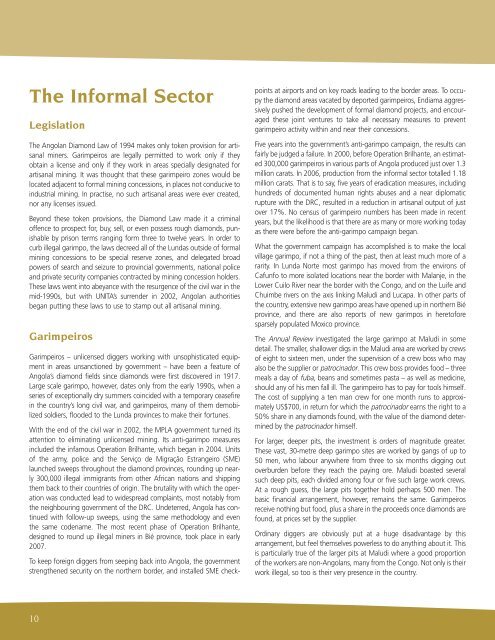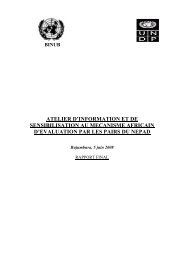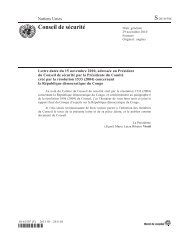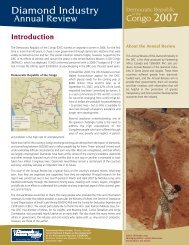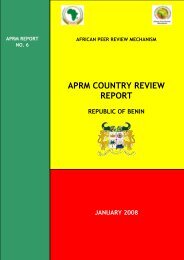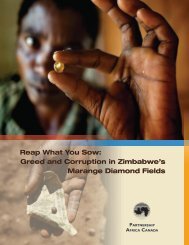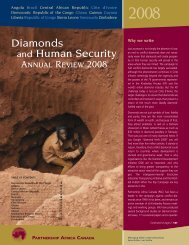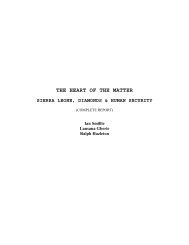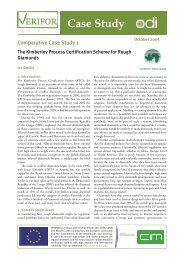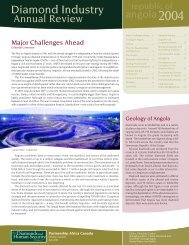Angola 2007 - Diamond Development Initiative
Angola 2007 - Diamond Development Initiative
Angola 2007 - Diamond Development Initiative
- No tags were found...
You also want an ePaper? Increase the reach of your titles
YUMPU automatically turns print PDFs into web optimized ePapers that Google loves.
The Informal SectorLegislationThe <strong>Angola</strong>n <strong>Diamond</strong> Law of 1994 makes only token provision for artisanalminers. Garimpeiros are legally permitted to work only if theyobtain a license and only if they work in areas specially designated forartisanal mining. It was thought that these garimpeiro zones would belocated adjacent to formal mining concessions, in places not conducive toindustrial mining. In practise, no such artisanal areas were ever created,nor any licenses issued.Beyond these token provisions, the <strong>Diamond</strong> Law made it a criminaloffence to prospect for, buy, sell, or even possess rough diamonds, punishableby prison terms ranging form three to twelve years. In order tocurb illegal garimpo, the laws decreed all of the Lundas outside of formalmining concessions to be special reserve zones, and delegated broadpowers of search and seizure to provincial governments, national policeand private security companies contracted by mining concession holders.These laws went into abeyance with the resurgence of the civil war in themid-1990s, but with UNITA’s surrender in 2002, <strong>Angola</strong>n authoritiesbegan putting these laws to use to stamp out all artisanal mining.GarimpeirosGarimpeiros – unlicensed diggers working with unsophisticated equipmentin areas unsanctioned by government – have been a feature of<strong>Angola</strong>’s diamond fields since diamonds were first discovered in 1917.Large scale garimpo, however, dates only from the early 1990s, when aseries of exceptionally dry summers coincided with a temporary ceasefirein the country’s long civil war, and garimpeiros, many of them demobilizedsoldiers, flooded to the Lunda provinces to make their fortunes.With the end of the civil war in 2002, the MPLA government turned itsattention to eliminating unlicensed mining. Its anti-garimpo measuresincluded the infamous Operation Brilhante, which began in 2004. Unitsof the army, police and the Serviço de Migração Estrangeiro (SME)launched sweeps throughout the diamond provinces, rounding up nearly300,000 illegal immigrants from other African nations and shippingthem back to their countries of origin. The brutality with which the operationwas conducted lead to widespread complaints, most notably fromthe neighbouring government of the DRC. Undeterred, <strong>Angola</strong> has continuedwith follow-up sweeps, using the same methodology and eventhe same codename. The most recent phase of Operation Brilhante,designed to round up illegal miners in Bié province, took place in early<strong>2007</strong>.To keep foreign diggers from seeping back into <strong>Angola</strong>, the governmentstrengthened security on the northern border, and installed SME checkpointsat airports and on key roads leading to the border areas. To occupythe diamond areas vacated by deported garimpeiros, Endiama aggressivelypushed the development of formal diamond projects, and encouragedthese joint ventures to take all necessary measures to preventgarimpeiro activity within and near their concessions.Five years into the government’s anti-garimpo campaign, the results canfairly be judged a failure. In 2000, before Operation Brilhante, an estimated300,000 garimpeiros in various parts of <strong>Angola</strong> produced just over 1.3million carats. In 2006, production from the informal sector totalled 1.18million carats. That is to say, five years of eradication measures, includinghundreds of documented human rights abuses and a near diplomaticrupture with the DRC, resulted in a reduction in artisanal output of justover 17%. No census of garimpeiro numbers has been made in recentyears, but the likelihood is that there are as many or more working todayas there were before the anti-garimpo campaign began.What the government campaign has accomplished is to make the localvillage garimpo, if not a thing of the past, then at least much more of ararity. In Lunda Norte most garimpo has moved from the environs ofCafunfo to more isolated locations near the border with Malanje, in theLower Cuilo River near the border with the Congo, and on the Luife andChuimbe rivers on the axis linking Maludi and Lucapa. In other parts ofthe country, extensive new garimpo areas have opened up in northern Biéprovince, and there are also reports of new garimpos in heretoforesparsely populated Moxico province.The Annual Review investigated the large garimpo at Maludi in somedetail. The smaller, shallower digs in the Maludi area are worked by crewsof eight to sixteen men, under the supervision of a crew boss who mayalso be the supplier or patrocinador. This crew boss provides food – threemeals a day of fuba, beans and sometimes pasta – as well as medicine,should any of his men fall ill. The garimpeiro has to pay for tools himself.The cost of supplying a ten man crew for one month runs to approximatelyUS$700, in return for which the patrocinador earns the right to a50% share in any diamonds found, with the value of the diamond determinedby the patrocinador himself.For larger, deeper pits, the investment is orders of magnitude greater.These vast, 30-metre deep garimpo sites are worked by gangs of up to50 men, who labour anywhere from three to six months digging outoverburden before they reach the paying ore. Maludi boasted severalsuch deep pits, each divided among four or five such large work crews.At a rough guess, the large pits together hold perhaps 500 men. Thebasic financial arrangement, however, remains the same. Garimpeirosreceive nothing but food, plus a share in the proceeds once diamonds arefound, at prices set by the supplier.Ordinary diggers are obviously put at a huge disadvantage by thisarrangement, but feel themselves powerless to do anything about it. Thisis particularly true of the larger pits at Maludi where a good proportionof the workers are non-<strong>Angola</strong>ns, many from the Congo. Not only is theirwork illegal, so too is their very presence in the country.10


